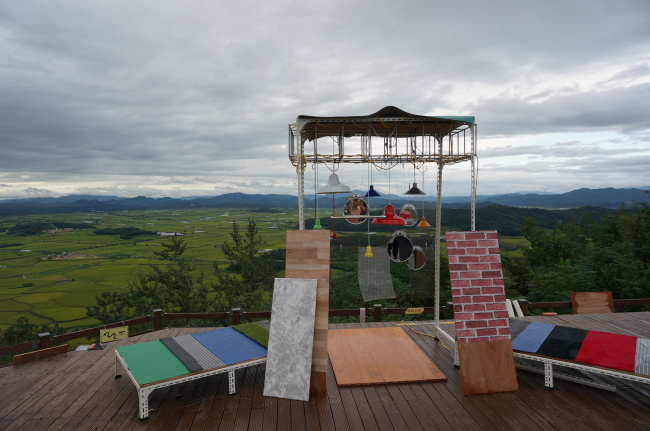CHEORWON, Gangwon Province ― Mount Soisan, a lowly hill just tens of meters across from a three-story building constructed by North Korea in 1946 as the Communist Party Headquarters, had a U.S. Army barrack and several secret bunkers that were used during the Korean War (1950-1953). Until 2001, civilians were prohibited from climbing the mountain as it was in the civilian control area adjacent to the demilitarized zone.
“Underneath where you stand are bunkers used during the war. This mountain is a bunker site,” said an official from Cheorwon district office.
Noted for its well-preserved nature, the 362-meter mountain recently turned into an art platform for the Real DMZ Project 2014. The mountain peak is now occupied by American-Cambodian artist Albert Samreth’s installations. Samreth set up a small temporary basketball court and acrylic structures there for the annual art project. He will also conduct a dance performance with local residents when the event opens on Aug. 31.
The installation commands a breathtaking view of vast rice fields in the South Korean parts of Cheorwon, rolling mountains that were once fierce battlegrounds, and in the distant horizon, North Korea.
 |
| “Dancers on a Plane” by Albert Samreth on the top of Mount Soisan in Cheorwon (Lee Woo-young/The Korea Herald) |
The bunker, which served as a situation room for South Korean soldiers, has transformed into an exhibition space featuring artist Koo Jeong-a’s fictional jumping character that imagines a “post-bunker Korea.”
“It is nothing like other exhibitions, given its format. It takes place in a public space, not within the safe boundaries of a museum. It deals with tension between two things: military politics and the everyday lives of farmers,” said Nikolaus Hirsch, a German architect and curator, who co-curated the project with Korean curator Kim Sun-jung.
Artworks now also fill once-restricted areas such as military bunkers or places that are manifestations of peace rhetoric such as the DMZ Peace Plaza and the Cheorwon Peace Observatory.
Starting this year, an artist residency program began in the farming village Yangji-ri. The village, founded in the 1970s as a propaganda settlement in the buffer zone, is now a temporary residence for artists, including Argentinian artist Adrian Villar Rojas, whose works explore the relationship between the place and local residents.
“I absolutely fell in love with the place. I decided to use it as a big theater,” the artist said during the press-guided tour. His temporary house exhibits installations made with objects he found during his stay.
The emergency shelter, built in the event of North Korean bombardment, will be filled with an acoustic installation by German sound artist Florian Hecker.
Argentinian artist Tomas Saraceno installed new binoculars in the Cheorwon Peace Observatory, a site where tourists on the DMZ tour come to get a glimpse into the restricted DMZ area and are briefed with war stories.
While the existing coin-operated binoculars stand right in front of the window that offers a limited view of the DMZ, Saraceno’s binoculars, which rotate 360 degrees from left to right and up and down, is a few steps behind it, allowing viewers more angles to enjoy the DMZ view. It also doesn’t require coins.
“His work gives freedom to the view looking over the DMZ and the North Korean territory,” Hirsch explained.
Aside from just artworks shown during the exhibition period, a chapter of an upcoming novel by German writer Ingo Niermann on a North and South Korea unification scenario will be read in Korean and English on the tour bus on the way to Cheorwon from Seoul.
Titled “De-Mechanized Zone,” the book envisions a situation in which North and South Koreans live together without machines, leading a primitive life.
Bringing together some 14 Korean and foreign artists from seven countries, the exhibition runs from Aug. 31 to Sept. 27 in the border area near the DMZ. The guided tour runs once a day except Tuesdays and during the Chuseok holiday.
The tour bus departs at 8:30 a.m. from Art Sonje Center in Seoul. The guided tour is 30,000 won per person, which includes transportation, lunch, entrance fee and a monorail ticket to the observatory.
For more information, call (02) 739-7067 or visit www.realdmz.org.
By Lee Woo-young (wylee@heraldcorp.com)



